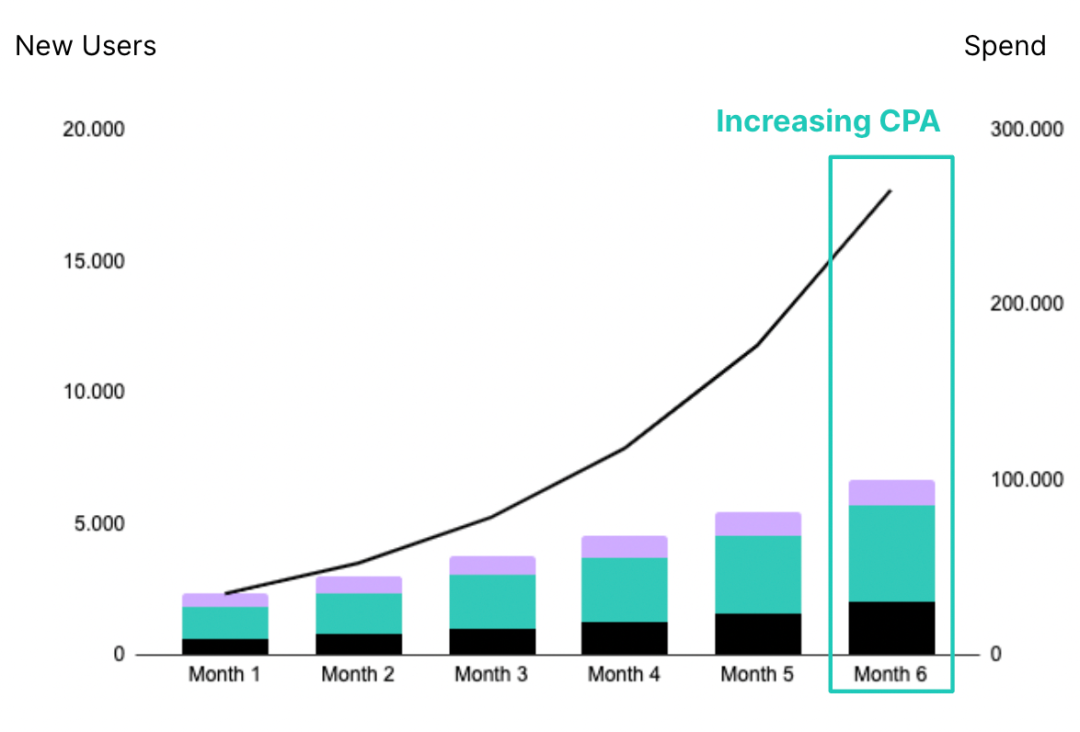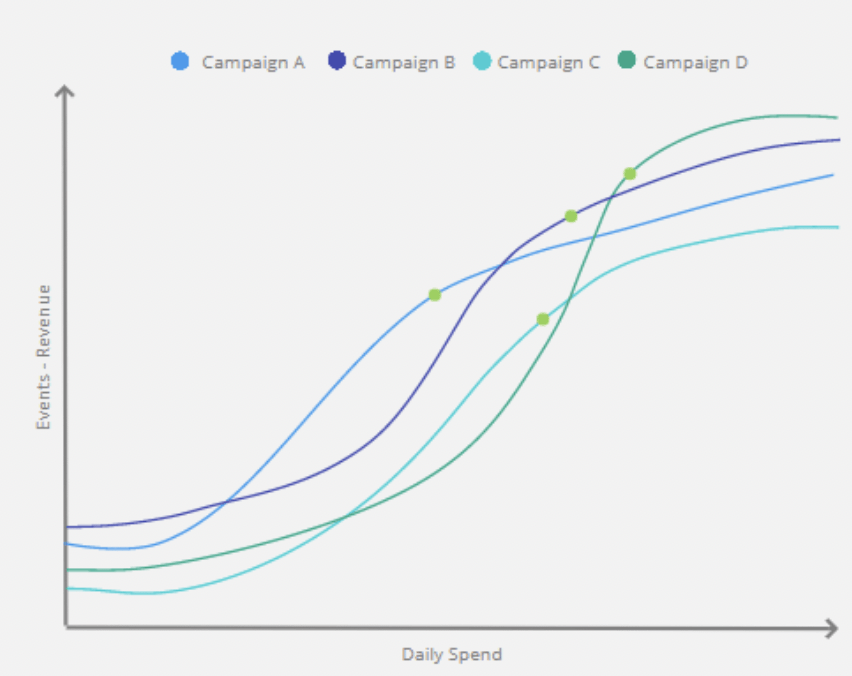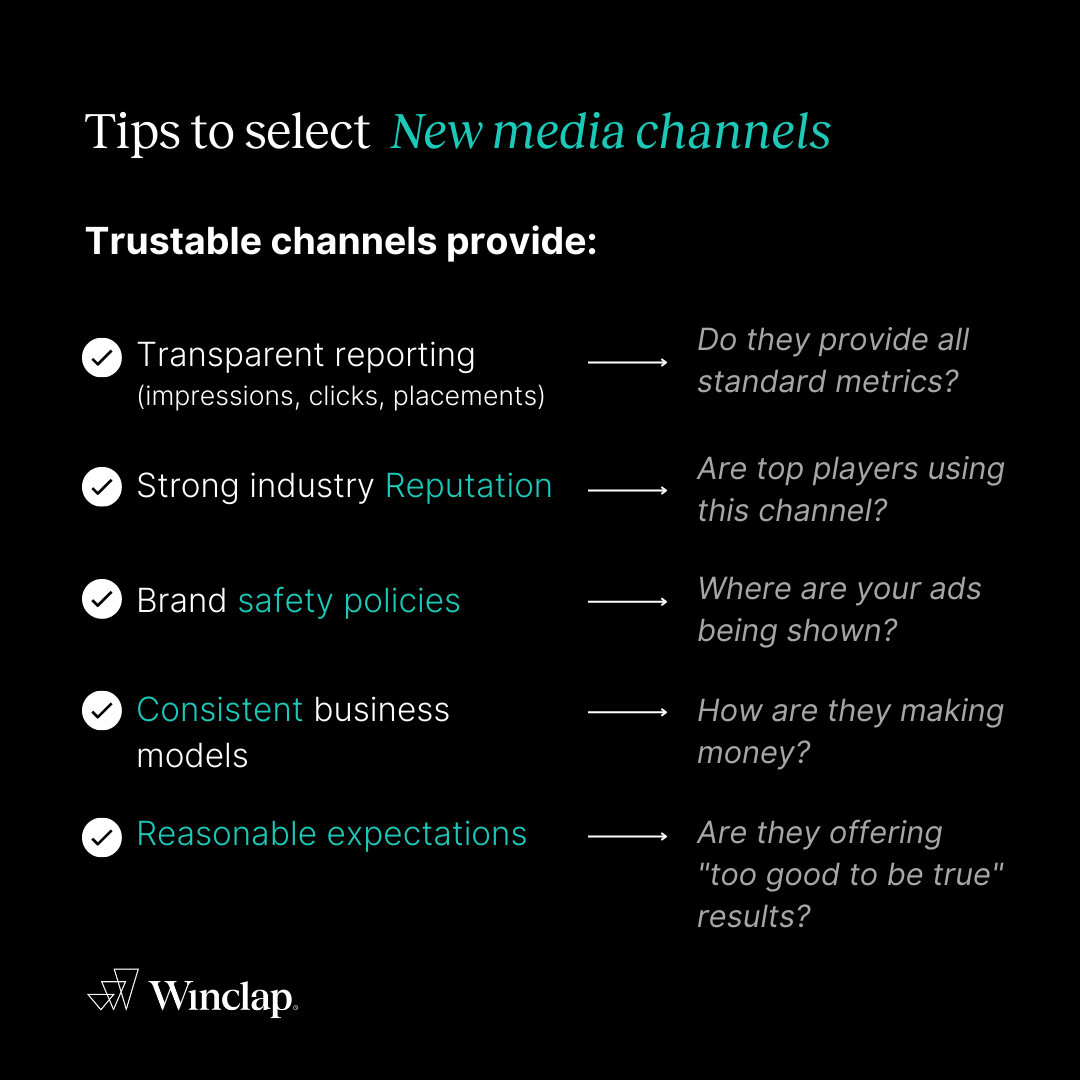BLOG | January 2, 2023
Marketing Efficiencies Playbook - Diversifying Channels
By Bernardo Tinti – Measurement & Impact Lead at Winclap
This article is part of the Marketing Efficiencies Playbook, a joint effort from Winclap and Softbank Latin America Fund to bring experts’ knowledge to leading startups and marketers to increase their efficiency and transform how they grow.
The Challenge of Finding New Channels
Every marketers knows that to scale growth, many times you have to increase your paid media spend. However, as your investment in advertisement grows the marginal return of that investment usually decreases. That means that for any additional dollar spent you get less additional users. Many times this is a problem of paid media channels saturation.
 Pedro de Arteaga, COO and VP USA (left), Gonzalo Varela, VP of Growth at Winclap (right) along with Amanda Ferracini, Marketing Leader at Softbank Latin America Fund (far right) at the Marketing Efficiency Workshop Sao Paulo edition, discussing with leading startups in Brazil how to diversify paid media effectively.
Pedro de Arteaga, COO and VP USA (left), Gonzalo Varela, VP of Growth at Winclap (right) along with Amanda Ferracini, Marketing Leader at Softbank Latin America Fund (far right) at the Marketing Efficiency Workshop Sao Paulo edition, discussing with leading startups in Brazil how to diversify paid media effectively.
Why do paid media channels saturate?
 As advertisement spend grows in a channel more ads are being shown and more users convert to those ads. Over time, channels saturate, meaning ads stop being as effective as they are shown to less relevant users. This increases costs and decreases ROAS. However it can be fixed by opening new media channels with fresh audiences and incremental users. The challenge is to find these channels.
As advertisement spend grows in a channel more ads are being shown and more users convert to those ads. Over time, channels saturate, meaning ads stop being as effective as they are shown to less relevant users. This increases costs and decreases ROAS. However it can be fixed by opening new media channels with fresh audiences and incremental users. The challenge is to find these channels.
Let’s say we are running an user acquisition campaign in three channels (A, B, C). As we increase the budget month over month we see an increment in the number of new users brought by these channels’ campaigns. However, as we can see on Graph 1, over time, the increase in spend is not linearly correlated to the increase in new users. In simple words, users do not increase as fast as we increase spend. We might be in the presence of channel saturation. This happens because as you increase your spend, the advertisement placement bought with those additional dollars gets served to less relevant users. To put it another way, the channels have already showed your ads to the most relevant users, and their algorithms are having trouble finding additional users that find your ad suitable.
In order to overcome channel saturation, it is necessary to diversify. That means investing in new channels that would find relevant additional users to show the ads to. (we use the word “relevant” repeatedly because we are referring to users that find your ad relevant and are likely to convert once they see it). Thus, adding new channels can bring higher marginal returns on investment (ROI). Or to put it in simple terms, it will bring more users for every dollar spent. This makes your media buying more efficient.
 As you start seeing channel saturation (in this graph this is reflected by the flattening of the curves), investing in new media channels can increase your marginal return of investment. (See how some channels curves have steeper slopes)
As you start seeing channel saturation (in this graph this is reflected by the flattening of the curves), investing in new media channels can increase your marginal return of investment. (See how some channels curves have steeper slopes)
Common Challenges for Channel Diversification
Majority of marketers already know that is desirable to have a diverse channel portfolio in your media mix. (OK, you may now wonder what is the purpose of this article then) However, although this sounds simple, it’s not easy. There are obstacles in the path towards channel diversification. Let’s see some of them:
- Lack of channel experience:
Many marketer and paid media analysts are acquainted with the biggest ad media platforms, specially Self Attributed Networks like Meta or Google. As a matter of fact, these are the channels that marketers prefer to run internally with in-house teams. However, when starting to work with new channels like programmatic, SDK partners or even other social medias, marketers may not be used to their optimization levers, ad placements, audience segmentation, and other channel specific features.
- Producing the right content for each channel:
Even if marketers are acquainted with new channels mechanisms, they will need to produce specific content following each channels creative nature. A challenge arises both in terms of asset quality and quantity: Channels like TikTok, for example, require to adopt a very specific ad mindset focusing on short videos while leveraging on trends and creatives. Performing TikTok assets can be hard to produce at first for an inexperienced team. Moreover, as new channels enter the media mix, the creative asset load increases. Meaning more ad assets in multiple formats need to be refreshed and optimized more often. Not all marketing teams count with the necessary bandwidth from their creative design team to deliver accordingly.
- Testing risks:
This is related to the lack of experience mentioned before. When running a new channel for the first time, performance could be subpar at the beginning. Programmatic channels usually carry longer learning curves. CAC may be higher during the first weeks of the campaigns as algorithms take time to collect data to learn how to optimize to the most appropiate users. This can result in higher overall CPA or lower ROAS at first (which is the opposite of what we are looking for with channel diversification). However, working with an experienced paid media specialist, understanding how testing works and managing initial expectations will help achieving the desired performance in new channels in the short term.
- Fraud:
Not all channels are created equal, some are less transparent than others. When looking for new channels, marketers may come across promising ad networks with attractive low-risk fixed CPA schemes and fast-pace user acquisition. (what a mix!) However, many times these channels have few optimization levers (i.e. there are not many “buttons” that marketers can control), unclear ad placements (lack of visibility of where the ads are being shown) and show suspicious attribution trends over other paid and organic sources. (they are working much better than anything else) Although initial metrics for these type of channels look quite attractive at first (e.g remarcable low CPAs), a thorough analysis can discover that these can be “too good to be true”, and may discover an underlining Ad Fraud. We cover more about Ad Fraud on this post.
Luckily, these challenges can be overcome. With the right media knowledge, creative experts and testing and measurements capabilities, marketing teams can succesfully diversificate their paid media mix. For example, at Winclap our Paid Media solution is comprised of a diverse team of Growth Partners, Performance Specialists, Creative Specialist, Growth Engineers and a Measurement and impact analysts, working together to grow our clients user base through multiple channels.
Now that we understand better the risks and benefits from channel diversification let’s see some tips to assess a new media channel.
“Adding channels to your paid media mix will help bringing more users for every dollar spent.
This makes your media buying more efficient.”
How to select and evaluate a new channel
 From Social and Search, to Programmatic, SDK Partners and On-Device ad solutions, there are a myriad of networks that can help you diversify your paid media mix. However, due dilligence is important to understand which can be the most appropiate channel for your brand.
From Social and Search, to Programmatic, SDK Partners and On-Device ad solutions, there are a myriad of networks that can help you diversify your paid media mix. However, due dilligence is important to understand which can be the most appropiate channel for your brand.
One of the most important step in Channel Diversification is to conduct the due dilligence. This means asking questions to understand how a media channel works before investing advertising money into it.
To make it easier, we have prepared a Checklist to Evaluate an Advertising Partner, where you can find different questions to consider when vetting for a new channel. These questions are useful both for evaluating channel-fit before investing, and to assess your initial performance once you started trying it out.
Company: overall, you should start questioning how the company is structured. It is important to understand how many employees the media channel has, their underlying technology, how are they providing support to advertisers, and what is their main value proposition. Their business should make sense to you.
Buying Model: how are they charging for the advertisement? do they offer fix or variable costs? Do they manage their own inventory or are they buying from third parties?
Clients: who else is advertising in this channel? Do they have success stories with reputable advertisers? Getting references from an actual client of them can provide useful information.
Audience, Ad Volume and Performance: once you started running campaigns in the new channel, it is key to ask questions on the initial performance. What kind of audience are the ads being shown to? Is the audience relevant for your business? What metrics are they showing as performance indicators? How does these metrics compare to the benchmarks from other partners? If you are seeing “too good to be true” results maybe they aren’t.
Data transparency and Fraud: are they providing info on impressions and clicks? Is data clear and accessible? Trusted partners should offer pre and post install suspicious pattern detection and exhaustive checks on publisher clients and publisher apps.
 Always ask questions before investing in a new paid media channel. To make it easier we have compiled a Checklist to help you evaluate an advertising partner. If you have further questions, please reach us at hello@winclap.com.
Always ask questions before investing in a new paid media channel. To make it easier we have compiled a Checklist to help you evaluate an advertising partner. If you have further questions, please reach us at hello@winclap.com.
Urged by the need to deliver results fast, many times we bypass this kind of checks when working with a new partner. Specially if they are promising a seamless onboarding and guaranteed low results. Let us be clear, there are many reputable channels with great technology, experienced teams that can deliver excellent results relatively fast. However, it usually takes time, questioning and testing before we can incorporate a new channel into the media mix.
At Winclap we strive to make that process at smooth as possible. As with many things in life, slow is smooth, and smooth is fast. We work with marketers to prove that having a diversified media strategy helps them being more efficient and increases their ROI on their paid media investment.
Our goal is that marketers transform how they approach their media buying strategy and disrupt every step of their growth cycle.
Our goal is to transform how they grow.
If you enjoyed this post be sure to check other articles of the Marketing Efficiency Playbook, where we talk about LTV Optimization, Fraud, Incrementality and more.